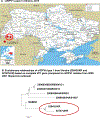Responding to a cVDPV1 outbreak in Ukraine: Implications, challenges and opportunities
- PMID: 28528761
- PMCID: PMC10465089
- DOI: 10.1016/j.vaccine.2017.04.036
Responding to a cVDPV1 outbreak in Ukraine: Implications, challenges and opportunities
Abstract
Background: The European Region, certified polio-free in 2002, remains at risk of wild poliovirus reintroduction and emergence of circulating vaccine-derived polioviruses (cVDPV) until global polio eradication is achieved, as demonstrated by the cVDPV1 outbreak in Ukraine in 2015.
Methods: We reviewed epidemiologic, clinical and virology data on cVDPV cases, surveillance and immunization coverage data, and reports of outbreak-related surveys, country missions, and expert group meetings.
Results: In Ukraine, 3-dose polio vaccine coverage declined from 91% in 2008 to 15% by mid-2015. In summer, 2015, two unrelated children from Zakarpattya province were paralyzed by a highly divergent cVDPV1. The isolates were 20 and 26 nucleotide divergent from prototype Sabin strain (with 18 identical mutations) consistent with their common origin and ∼2-year evolution. Outbreak response recommendations developed with international partner support included conducting three nationwide supplementary immunization activities (SIAs) with tOPV, strengthening surveillance and implementing communication interventions. SIAs were conducted during October 2015-February 2016 (officially reported coverage, round 1-64.4%, round 2-71.7%, and round 3-80.7%). Substantial challenges to outbreak response included lack of high-level support, resistance to OPV use, low perceived risk of polio, widespread vaccine hesitancy, anti-vaccine media environment, economic crisis and military conflict. Communication activities improved caregiver awareness of polio and confidence in vaccination. Surveillance was enhanced but did not consistently meet applicable performance standards. Post-outbreak assessments concluded that cVDPV1 transmission in Ukraine has likely stopped following the response, but significant gaps in population immunity and surveillance remained.
Conclusions: Chronic under-vaccination in Ukraine resulted in the accumulation of children susceptible to polioviruses and created favorable conditions for VDPV1 emergence and circulation, leading to the outbreak. Until programmatic gaps in immunization and surveillance are addressed, Ukraine will remain at high-risk for VDPV emergence and circulation, as well as at risk for other vaccine-preventable diseases.
Keywords: Circulating vaccine-derived poliovirus (cVDPV) outbreak; Polio outbreak response; Poliomyelitis; Supplementary immunization activities (SIA); Ukraine; WHO European Region.
Published by Elsevier Ltd.
Conflict of interest statement
Conflict of interest
None declared.
Figures



Similar articles
-
Update on Vaccine-Derived Poliovirus Outbreaks - Worldwide, January 2020-June 2021.MMWR Morb Mortal Wkly Rep. 2021 Dec 10;70(49):1691-1699. doi: 10.15585/mmwr.mm7049a1. MMWR Morb Mortal Wkly Rep. 2021. PMID: 34882653 Free PMC article.
-
Update on Vaccine-Derived Poliovirus Outbreaks - Worldwide, January 2021-December 2022.MMWR Morb Mortal Wkly Rep. 2023 Apr 7;72(14):366-371. doi: 10.15585/mmwr.mm7214a3. MMWR Morb Mortal Wkly Rep. 2023. PMID: 37022974 Free PMC article.
-
[Circulating vaccine-derived poliovirus type 2 outbreak in Democratic Republic of Congo 2011-2012].Bull Soc Pathol Exot. 2015 Oct;108(4):235-41. doi: 10.1007/s13149-015-0447-4. Epub 2015 Aug 18. Bull Soc Pathol Exot. 2015. PMID: 26288132 French.
-
Circulating vaccine-derived polioviruses: current state of knowledge.Bull World Health Organ. 2004 Jan;82(1):16-23. Epub 2004 Feb 26. Bull World Health Organ. 2004. PMID: 15106296 Free PMC article. Review.
-
New insights into physiopathology of immunodeficiency-associated vaccine-derived poliovirus infection; systematic review of over 5 decades of data.Vaccine. 2018 Mar 20;36(13):1711-1719. doi: 10.1016/j.vaccine.2018.02.059. Epub 2018 Feb 23. Vaccine. 2018. PMID: 29478755 Review.
Cited by
-
Challenges in assessing the immunization status of adults in Germany-lessons from a population-based VACCELERATE survey on polio vaccination.Infection. 2024 Aug;52(4):1563-1574. doi: 10.1007/s15010-024-02296-9. Epub 2024 May 28. Infection. 2024. PMID: 38806974 Free PMC article.
-
A circulating vaccine-derived poliovirus type 2 outbreak in a chronic conflict setting: a descriptive epidemiological study in South Sudan - 2020 to 2021.BMC Infect Dis. 2023 Nov 21;23(1):816. doi: 10.1186/s12879-023-08758-z. BMC Infect Dis. 2023. PMID: 37990165 Free PMC article.
-
Parents' Attitudes towards Vaccinations Regarding the Ukrainian Migration to Poland in 2022.Vaccines (Basel). 2023 Jul 31;11(8):1306. doi: 10.3390/vaccines11081306. Vaccines (Basel). 2023. PMID: 37631872 Free PMC article.
-
Polio vaccination activities in conflict-affected areas.Hum Vaccin Immunother. 2023 Aug 1;19(2):2237390. doi: 10.1080/21645515.2023.2237390. Hum Vaccin Immunother. 2023. PMID: 37489591 Free PMC article. Review.
-
Impact of pandemics and disruptions to vaccination on infectious diseases epidemiology past and present.Hum Vaccin Immunother. 2023 Aug 1;19(2):2219577. doi: 10.1080/21645515.2023.2219577. Epub 2023 Jun 8. Hum Vaccin Immunother. 2023. PMID: 37291691 Free PMC article. Review.
References
-
- World Health Organization. Certification of poliomyelitis eradication. In: Fifteenth meeting of the European regional certification commission, Copenhagen, 19–21 June 2002. Copenhagen, Denmark: World Health Organization; 2005. p. 1–128.
-
- Anis E, Kopel E, Singer SR, et al. Insidious reintroduction of wild poliovirus into Israel, 2013. Eurosurveillance 2013;18:2–6. <http://www.eurosurveillance.org/ViewArticle.aspx?ArticleId=20586>. [accessed 28 September 2016]. - PubMed
-
- State Statistics Service of Ukraine. Population of Ukraine. <http://database.ukrcensus.gov.ua/PXWEB2007/eng/news/op_popul_e.asp> [accessed 26 November 2016].
Publication types
MeSH terms
Substances
Grants and funding
LinkOut - more resources
Full Text Sources
Other Literature Sources
Medical

